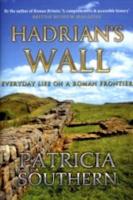
Amberley (2019) p/b 464pp £10.99 (ISBN 9781445690759)
In their promotional material the publishers tell us that this book is ‘The only history to include the everyday life of troops manning the wall and their interactions with the local population, as well as the building and afterlife of the Roman ruin.’
It is indeed true that following the deciphering of the Vindolanda tablets with their homely social chit-chat and the continuing excavations at that site, there is more material available and greater general interest in the day to day life of those who served and lived along the wall.
S.’s chapter ‘Living on the Wall: Soldiers and Civilians’ is packed with detailed discussions of the roles of military personnel, senior and junior, legionaries and auxiliaries, based on literary, epigraphical and archaeological sources, including documents rescued from the mud of Vindolanda or the sands of Egypt. From Vindolanda we learn the example of a cornicularius (a senior clerk) called Severus, who is concerned about the cost of food for celebrating the Saturnalia. We learn what the soldiers wore, what they ate, where they slept, and how they were paid etc. etc. S. also describes the vici (civilian settlements), which grew up around the forts and how they were regulated.
But it would be wrong to see this book’s strength only in its description of ‘everyday’ life. It is in fact a comprehensive history of Rome’s engagement with (largely northern) Britain, from Julius Caesar probing landings in 55 and 54 BC until the expulsion of the Roman government officials in c. 409 AD. S., already a highly respected historian and biographer, is a born teacher, with a penchant for elaborating in a brief excursus on many of the topics she discusses, for example, comparing the Emperor Hadrian’s and William the Conqueror’s assessments of the wisdom of trying to conquer Scotland.
Nothing is skimmed over in this wide-ranging study—the stages by what is now northern England was pacified, the generals involved, the precursors of the wall, the building materials, the individual forts, the surrounding communities are all thoroughly discussed with diagrams and line drawings in abundance and 16 pages of colour photographs.
S. is quick to point out how little is known for certain on so many issues relating to the wall and its history. For example: what was the purpose of the circular stone-built huts (possibly 200 or more) whose foundations were discovered within the fort at Vindolanda? S. lists and attributes various suggestions that have been made—to accommodate hostages, or refugees, or foreign levies, or conscript labour. But she does not come down in support of any particular suggestion. Her approach is not that of an advocate arguing a case, but of a judge reviewing the evidence and inviting the jurors (her readers) to distinguish between established fact and what is speculation with varying degrees of probability.
This carefully balanced approach reaches its apogee in the final chapter entitled ‘How did the wall work?’ She considers to what extent it was for protection, to mark a defensible boundary, to regulate trade, to demonstrate power… She tells us that the short answer is that ‘nobody knows’, but she leaves us with a masterclass in the judicious review of evidence.
With comprehensive notes, bibliography and index this a most stimulating book which almost literally leaves no stone unturned for all interested in what is, for most Britons, ‘The Wall’.
Ray Morris
